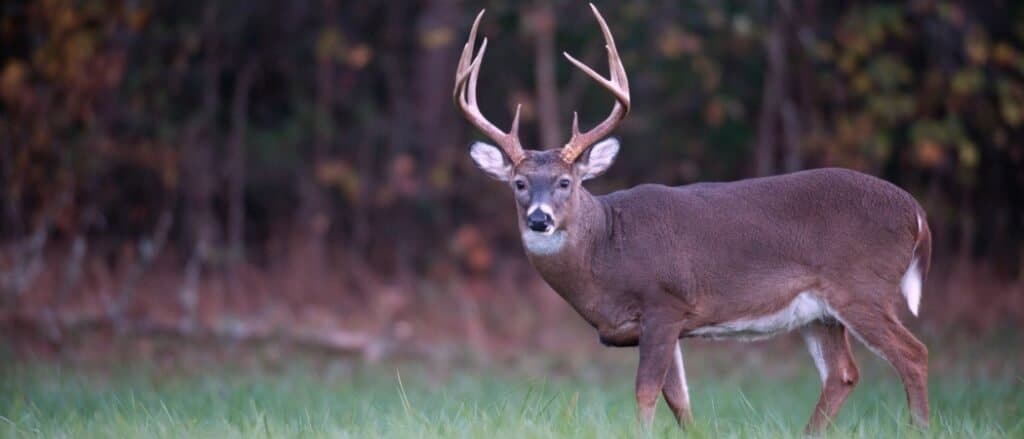Whitetail deer are common across North America, but they are also native to South and Central America. You can find them as far south as Peru and Bolivia. These large and beautiful animals are popular to hunt. While they don’t put up a big fight, they are fast runners and use their senses to hide from prey, including humans. In Arizona, they are very common. Whitetail deer hunting season in Arizona is generally at the end of the year. Follow along to discover the largest whitetail deer ever caught in Arizona.
The Largest Whitetail Deer Ever Caught In Arizona
The largest typical whitetail deer ever caught in Arizona scored 144-1/8 points. This deer is also the largest Coues’ whitetail deer in the world. Ed Stockwell shot the large whitetail deer in Pima County, Arizona after a short chase in 1953 when the deer tried to escape into the mountains. The whitetail deer scored 144-1/8 points, but not before it was re-examined. Many people were skeptical of this massive whitetail deer and believed it wasn’t a Coues.

The largest whitetail deer ever caught in Arizona scored 144 -1/8 points.
©EEI_Tony/Shutterstock.com
About The Whitetail Deer
Whitetail deer are unique animals. They live in many types of environments including mountainous terrain and dense forests. Currently, there are 26 subspecies in North America.
Size and Appearance
Whitetail deer, as their name suggests, have short white tails. Apart from their ears and under their bellies, whitetail deer have red or brown coats. Their coats change color with each season. During fall and winter, they have grey-brown coats, which better help them blend into their surroundings. Whitetail deer also have longer snouts, which is also an indicator of age. Older whitetail deer have longer snouts. Male whitetail deer also have antlers. Although 1 in 10,000 females grow antlers, it’s likely because of freemartinism. Male deer, known as bucks, regrow their antlers every year. Their antlers branch off into ‘spikes’. The length depends on the deer’s age.
These beautiful animals vary a lot in size and weight. Their size and weight depend on the region they live in and the subspecies. For instance, whitetail deer living farther from the equator are larger than those living closer. Bucks weigh between 150 to 300 pounds but can surpass 400 pounds. The larger whitetail deer live in the northern parts of their native reach including U.S. states like Minnesota. Females are a lot smaller, with an average weight of 88 to 198 pounds. One of the smallest whitetail deer subspecies is the Florida key deer. These deer that live in the tropics weigh about 77 to 110 pounds. However, some females are very small, weighing as little as 55 pounds.
Diet
Whitetail deer are mainly herbivores. Their specific diets depend on where they live and the season. However, most whitetail deer eat a lot of legumes, shoots, cacti, leaves, and grasses. Whitetail deer living in forests forage for fruit and acorns. Whitetail deer have multi-chambered stomachs, which can properly digest toxic plants like poison ivy. Some whitetail deer also eat mushrooms. While rare, if a whitetail deer is out of options, it can eat field mice and vulnerable birds. Whitetail deer are mainly spotted in the “edges” of forests, where there is more food. The average adult whitetail deer eats 2,000 pounds of plant matter each year.

Female whitetail deer are smaller than males, weighing between 88 and 198 pounds.
©Charles T. Peden/Shutterstock.com
Predators
Whitetail deer are fast and cunning and they have to be! These beautiful deer have many natural predators including coyotes, wolves, jaguars, and humans. American alligators also attack small or injured whitetail deer. This is more common when whitetail deer are near a water source. Other predators attack young fawns like black bears, bobcats, and wolverines. While vultures and other scavenger birds don’t attack whitetail deer, they eat their carrion. Although rare and unsuccessful, some experts have observed and recorded American crows and common ravens pecking the eyes of young deer fawns to prey on them.
Whitetail deer mainly rely on their speed to get away from predators. When they spot potential predators, they breathe hard, which alerts other deer in the area that a threat is near. After they breathe, they run quickly seeking shelter. Whitetail deer can sprint up to 40 mph. They’ve been recorded running 30 mph consistently. Although not as common, whitetail deer attack when they feel threatened. They lunge quickly toward their predators with their antlers.
Distribution
While whitetail deer are most common in North, South, and Central America, these medium-sized deer have been introduced to other parts of the world, like the Caribbean. They are found throughout Mexico except for lower California. Interestingly, Texas is home to the largest whitetail deer population in the U.S. and Canada with over 5.3 million deer. Whitetail deer live in a wide variety of habitats but prefer wooded areas. Although this is true, they also live in parries and open fields.

The largest whitetail deer ever caught in Arizona was shot in 1953. Its size was so massive, it was measured more than once to confirm.
©iStock.com/Lightwriter1949
Where Is Pima County, Arizona Located On A Map?
Pima County is situated in the southeast region of the state, which includes the cities of Tuscon, Marana and Green Valley. Arizona is located in the southwestern region of the United States and is part of the four corners region, the only location in the United States where four states meet – in the southwest with Utah to the north, Colorado to the northeast, and New Mexico to the east. Arizona is also bordered by California to the west, Utah to the north, New Mexico to the east, Nevada to the northwest, and the Mexican states of Sonora and Baja California to the west.
The photo featured at the top of this post is © Tom Reichner/Shutterstock.com
Thank you for reading! Have some feedback for us? Contact the AZ Animals editorial team.






